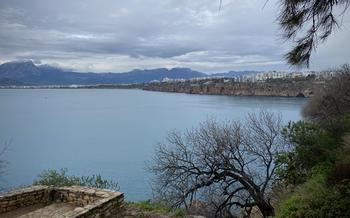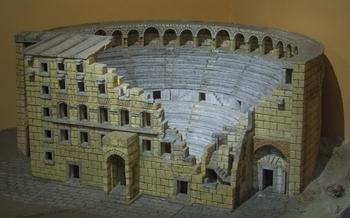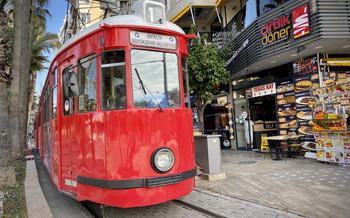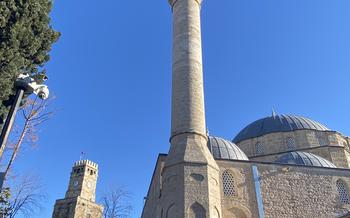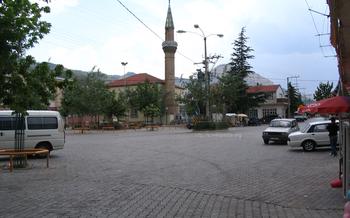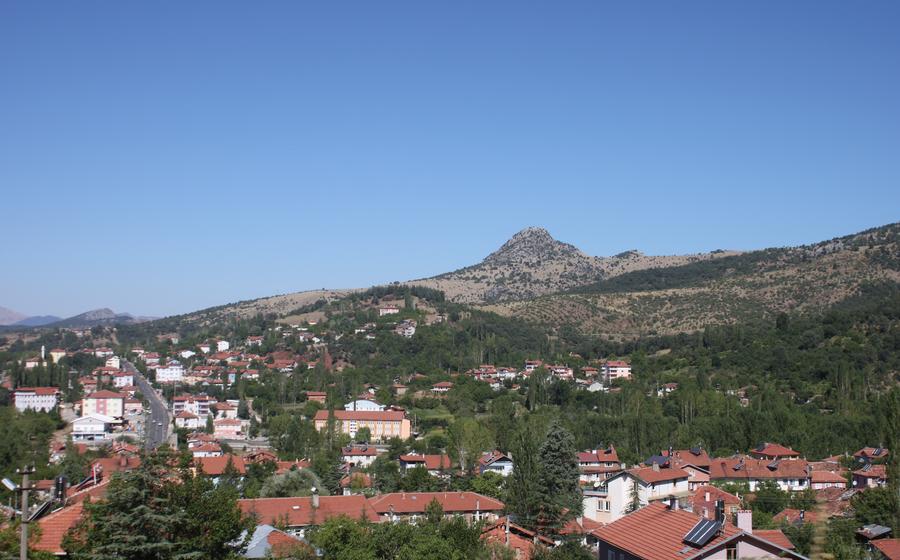
Bucak Aspendos Theater
- The Antiquity of Bucak Aspendos Theater
- Location of the Theater
- Architectural Features of the Theater
- Historical Significance of the Theater
- Events and Performances at the Theater
- Visiting the Theater
- What to See and Do at the Theater
- Nearby Attractions
- Insider Tip: Visiting the Theater During Off-Peak Hours
- Unique Features of the Theater
- History of the Theater's Construction
- How to Get to the Theater
- Tips for Visiting the Theater
- Local Culture and Traditions
- Insider Tip: Exploring the Theater at Night
The Antiquity of Bucak Aspendos Theater
The Bucak Aspendos Theater, nestled in the heart of Turkey's Isparta province, stands as a testament to the rich cultural heritage of the ancient world. Its origins can be traced back to the 2nd century AD, during the reign of the Roman Emperor Marcus Aurelius. Constructed by the prominent Roman architect Zenon, the theater served as a focal point for entertainment and cultural events in the thriving city of Aspendos.
The architectural style of the Bucak Aspendos Theater is a blend of Greek and Roman influences, showcasing the fusion of two great civilizations. Its imposing facade, adorned with intricate carvings and sculptures, reflects the grandeur of the Roman Empire. The theater's well-preserved state allows visitors to marvel at the architectural prowess of ancient builders, who skillfully crafted this masterpiece using locally sourced materials.
Comparisons with other ancient theaters reveal the uniqueness of the Bucak Aspendos Theater. While it shares similarities with renowned theaters such as the Aspendos Theater in Antalya, the Bucak theater possesses a distinct charm and character. Its smaller size, with a seating capacity of approximately 5,000, creates an intimate atmosphere, allowing for a more immersive experience for audiences.
Location of the Theater
The Bucak Aspendos Theater is conveniently situated in the heart of the city of Bucak, within easy reach of a variety of other attractions, making it an ideal destination for history and culture enthusiasts. The theater's proximity to other ancient sites, such as the Bucak Archaeological Museum and the nearby Roman ruins, allows visitors to delve deeper into the region's rich history and immerse themselves in the captivating narratives of the past.
The theater is easily accessible by public transportation, with several bus routes stopping nearby, ensuring a hassle-free journey for visitors who prefer to leave their cars behind. Additionally, there is ample parking available in the vicinity of the theater, catering to those who choose to drive. Whether you're traveling solo, with friends, or as a family, the Bucak Aspendos Theater offers a convenient and accessible experience for all.
Architectural Features of the Theater
The Bucak Aspendos Theater ranks among the most splendid and well-preserved ancient theaters in Turkey. Its colossal seating capacity, estimated to accommodate over 15,000 spectators, is a testament to the theater's significance as a cultural and entertainment hub in ancient times. The cavea (seating area) is divided into two tiers, with the lower tier featuring 20 rows of seats and the upper tier comprising 19 rows. The stage (skene) is adorned with elaborate reliefs and sculptures, while the orchestra (circular area in front of the stage) is vast and spacious.
The theater's acoustics are remarkable, ensuring that even those seated in the uppermost rows could clearly hear the actors' voices. This acoustic excellence is attributed to the theater's ingenious design, which takes advantage of the natural reverberation of sound within the stone structure. The sightlines are also carefully planned, providing unobstructed views of the stage from every seat in the theater. This combination of exceptional acoustics and sightlines made the Bucak Aspendos Theater a prime venue for theatrical performances, musical concerts, and other events in ancient times.
Historical Significance of the Theater
The Bucak Aspendos Theater ranks among the most historically significant ancient theaters in Turkey. During antiquity, it served as the cultural and entertainment hub of the ancient city of Aspendos. The theater played a crucial role in ancient Greek and Roman society, hosting a variety of performances and events that reflected the cultural and artistic achievements of the era.
The theater was primarily used for dramatic performances, including tragedies, comedies, and satyr plays. These plays often addressed significant social and political issues, providing a platform for public discourse and commentary. Additionally, the theater was utilized for musical performances, poetry recitals, and dance exhibitions, showcasing the diverse artistic talents of the ancient world.
Beyond its role in entertainment, the Bucak Aspendos Theater held religious and civic significance. It served as a venue for religious festivals and ceremonies, honoring the gods and goddesses of the ancient Greek and Roman pantheons. Moreover, the theater functioned as a gathering place for political assemblies, public meetings, and civic announcements, facilitating community engagement and decision-making.
The theater's historical importance extends to its exceptional preservation and restoration efforts. Despite the passage of time and the challenges of natural disasters, the theater has undergone extensive restoration works, preserving its architectural integrity and ensuring its continued use for cultural events and performances.
Events and Performances at the Theater
Currently, the Bucak Aspendos Theater is a very popular venue for various events and performances, including the renowned Aspendos International Opera and Ballet Festival. During this festival, held annually, visitors can enjoy performances by world-class opera singers, ballet dancers, and musicians within these ancient walls. In addition to these special events, the theater also hosts regular performances, such as concerts, plays, and dance recitals, providing a platform for local and regional artists to showcase their talents. An up-to-date schedule of upcoming events can be found on the theater's official website.
Visiting the Theater
Visiting the Bucak Aspendos Theater is a captivating experience that allows you to step back in time and witness the grandeur of ancient architecture. The theater is open to the public daily, offering visitors the chance to explore its awe-inspiring ruins and immerse themselves in its rich history.
Admission fees are minimal, ensuring that everyone can enjoy this cultural treasure. Guided tours are available for those who want to delve deeper into the theater's history and significance. Audio guides are also available, providing insightful commentary as you explore the site at your own pace.
What to See and Do at the Theater
The Bucak Aspendos Theater offers a range of activities and attractions for visitors to enjoy:
-
Explore the Theater's Interior and Exterior: Embark on a self-guided tour of the theater, marveling at its intricate architectural details and impressive dimensions. Explore the seating tiers, stage, and orchestra, imagining the lively performances that once took place here. Don't miss the opportunity to capture stunning photographs of the theater's grand facade and surrounding landscapes.
-
Attend a Performance or Event: If you're fortunate enough to visit during the theater's performance season, seize the chance to witness a live show or event. Immerse yourself in the magic of a theatrical performance, musical concert, or cultural festival unfolding within the ancient walls of the theater. Check the theater's website or local listings for upcoming events and schedules.
-
Take a Guided Tour or Use an Audio Guide: Enhance your visit by opting for a guided tour or using an audio guide. These informative tours provide valuable insights into the theater's history, architecture, and significance. Learn about the ancient Greek and Roman traditions that shaped the theater's design and discover the stories behind the performances that graced its stage.
Nearby Attractions
The Bucak Aspendos Theater is surrounded by a wealth of other historical and cultural attractions. Just a short walk away, visitors can explore the ancient city of Aspendos, with its well-preserved ruins, including an impressive aqueduct and the remains of a temple dedicated to Apollo. The city also boasts a vibrant museum, showcasing artifacts from the region's rich past.
For those seeking a deeper dive into history, the nearby archaeological site of Perge offers an abundance of ruins and artifacts from the Hellenistic, Roman, and Byzantine periods. Visitors can wander among the remnants of temples, theaters, and public baths, providing a glimpse into the region's diverse cultural heritage.
Nature enthusiasts will delight in exploring the stunning Köprülü Canyon National Park, located just a short drive from the theater. The park offers breathtaking views of towering canyons, cascading waterfalls, and lush forests. Visitors can embark on scenic hiking trails, take a refreshing dip in the crystal-clear waters, or simply relax and soak in the tranquility of the natural surroundings.
Insider Tip: Visiting the Theater During Off-Peak Hours
One of the secrets of local travel enthusiasts is to avoid peak hours when visiting popular tourist attractions. This is especially true for the Bucak Aspendos Theater, which can get quite crowded during the summer months. If you want to enjoy a more intimate and peaceful experience, consider visiting the theater during the off-peak hours, which are typically during the early morning or late afternoon. During these times, you'll have the chance to explore the theater at your own pace, take stunning photos without the crowds, and soak in the tranquility of this ancient site. To avoid the crowds, it's best to visit the theater early in the morning, as soon as it opens. This way, you'll have plenty of time to explore the theater before the crowds arrive. You can also visit the theater late in the afternoon, as the sun begins to set. This is a magical time to visit the theater, as the golden light bathes the ruins in a warm glow.
Unique Features of the Theater
The Bucak Aspendos Theater stands out among ancient theaters for its exceptional architectural elements and historical significance. Its distinctive features include:
-
Elaborate Stage Building: The theater boasts an impressive stage building adorned with intricate carvings and sculptures depicting mythological scenes. These intricate embellishments enhance the theater's visual appeal and provide a glimpse into the artistic prowess of ancient craftsmen.
-
Well-Preserved Cavea: The cavea, or seating area, of the theater has been remarkably well-preserved, with many of the original stone seats still intact. This exceptional state of preservation allows visitors to experience the theater's original grandeur and imagine the vibrant atmosphere of performances held there centuries ago.
-
Unique Acoustical Properties: The theater's acoustics are renowned for their exceptional clarity and resonance. This remarkable acoustic quality was achieved through careful design and construction techniques, ensuring that even the most subtle sounds could be heard throughout the auditorium.
-
Historical Significance: The Bucak Aspendos Theater holds immense historical significance as one of the best-preserved examples of ancient Greek architecture in Turkey. Its enduring legacy as a cultural and artistic center has earned it recognition as a UNESCO World Heritage Site, attracting visitors from around the world.
History of the Theater's Construction
The Bucak Aspendos Theater was built during the reign of the Roman Emperor Marcus Aurelius in the 2nd century AD. The construction project was overseen by the wealthy and influential citizen Aspendos, who financed the theater's construction as a gift to his hometown. The theater was built using locally sourced materials, including limestone and marble, and was completed in a relatively short period of time thanks to the efforts of a large team of skilled workers.
The construction of the theater involved several challenges, including the need to create a stable and durable structure on uneven terrain, as well as the need to ensure that the theater's acoustics and sightlines were optimal. The theater's unique design, which features a series of vaulted arches and a stepped seating arrangement, helped to overcome these challenges and resulted in a theater that was both visually impressive and functionally efficient.
The theater's construction was a significant undertaking for the city of Bucak, and its completion was celebrated with a grand opening ceremony that featured performances by some of the most renowned actors and musicians of the time. The theater quickly became a popular venue for a variety of performances, including plays, concerts, and gladiator fights, and it remains an important cultural landmark in the region to this day.
How to Get to the Theater
The Bucak Aspendos Theater is situated in the town of Bucak, within the Isparta province of Turkey. Reaching the theater is relatively straightforward, with several accessible routes available.
Driving For those traveling by car, driving offers the most direct and convenient option. From major cities like Antalya and Isparta, follow the signs leading towards Bucak. Once in Bucak, the theater is situated in the town center, easily accessible via local roads.
Public Transportation Travelers without a vehicle can utilize public transportation to reach the theater. Regular bus services operate from Antalya and Isparta to Bucak. Upon arrival in Bucak, take a short taxi or local bus ride to the theater, which is within easy reach from the town center.
Guided Tours Participating in guided tours that include a visit to the Bucak Aspendos Theater is another excellent option. These tours often provide transportation from major cities or tourist hubs, eliminating the need for personal arrangements. Guided tours also offer the advantage of providing historical insights and commentary, enhancing the overall experience.
Tips for Visiting the Theater
Before embarking on your visit to the Bucak Aspendos Theater, familiarizing yourself with some practical tips will enhance your experience. First and foremost, dress appropriately for the occasion. While casual attire is generally acceptable, avoid wearing overly revealing or disrespectful clothing. Secondly, photography is permitted within the theater, but using a flash is prohibited, as it can disturb ongoing performances or damage the ancient ruins.
For visitors with disabilities, the theater offers accessible entrances and designated seating areas to ensure a comfortable and inclusive experience. Additionally, guided tours and audio guides are available in various languages to provide comprehensive insights into the theater's history and significance. By adhering to these guidelines and recommendations, you can fully immerse yourself in the captivating atmosphere of the Bucak Aspendos Theater.
Local Culture and Traditions
The Bucak Aspendos Theater is deeply embedded in the local culture and traditions of the region. For centuries, it has served as a gathering place for people to come together and celebrate their shared history and heritage. Today, the theater continues to play a vital role in the community, hosting a variety of cultural events and festivals throughout the year.
One of the most popular events held at the theater is the annual Aspendos Opera and Ballet Festival. This prestigious festival attracts world-renowned opera and ballet companies from around the globe, showcasing their talents on the theater's historic stage. The festival is a celebration of the arts and a testament to the enduring legacy of the Bucak Aspendos Theater.
In addition to the opera and ballet festival, the theater also hosts a variety of other cultural events, such as concerts, plays, and dance performances. These events provide opportunities for local artists to showcase their work and for the community to come together and enjoy a night of entertainment.
The Bucak Aspendos Theater is a symbol of the region's rich cultural heritage. Its presence serves as a reminder of the importance of preserving and celebrating the traditions of the past. Whether you are attending a performance or simply exploring the theater's grounds, you will be struck by its unique atmosphere and the sense of history that permeates the air.
Insider Tip: Exploring the Theater at Night
The Bucak Aspendos Theater takes on a magical aura when the sun sets and the stars come out. The ancient stone walls are illuminated, casting long shadows that dance across the theater's interior. The air is still and quiet, creating an atmosphere of tranquility that is perfect for contemplation and reflection.
There are several advantages to visiting the theater at night. First, the crowds are much smaller, so you can enjoy a more intimate experience. Second, the cooler temperatures make it more pleasant to explore the theater's interior and exterior. Third, the night sky provides a stunning backdrop for photos of the theater.
To make the most of your night visit, arrive at the theater just before sunset. This will give you time to explore the theater's exterior and take some photos before the sun goes down. Once it gets dark, find a seat in the theater and simply soak in the atmosphere. Let your imagination transport you back in time to when the theater was filled with spectators and the air was alive with the sound of music and laughter.
If you are lucky, you might even catch a glimpse of a shooting star as you gaze up at the night sky. Make a wish, and who knows, it might just come true!
Here are a few tips for enjoying a night visit to the Bucak Aspendos Theater:
- Bring a flashlight or headlamp to help you navigate the theater's interior.
- Dress warmly, as the temperatures can drop at night.
- Be aware of your surroundings and take precautions to stay safe.
- If you are visiting the theater with children, make sure to keep them close by.
